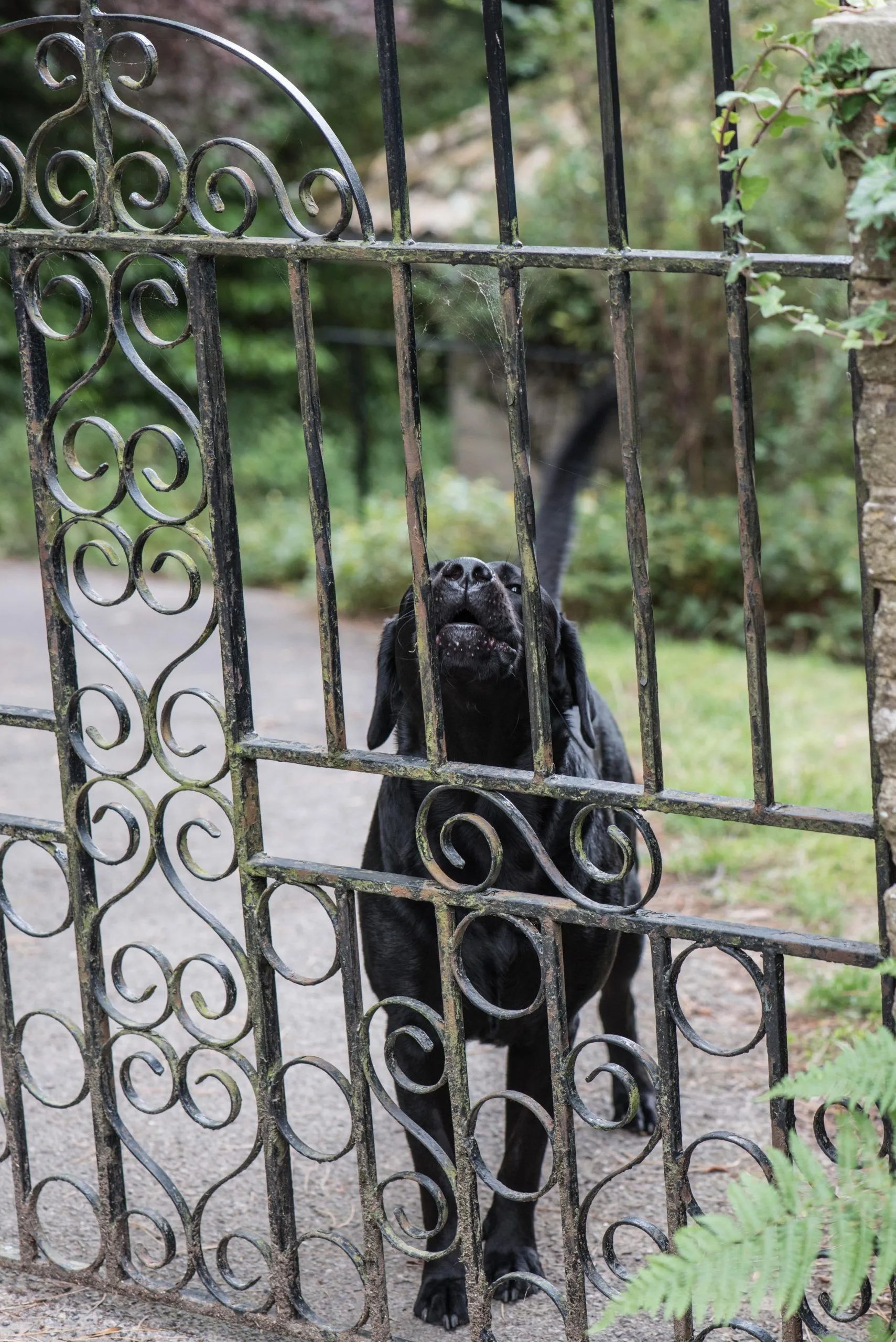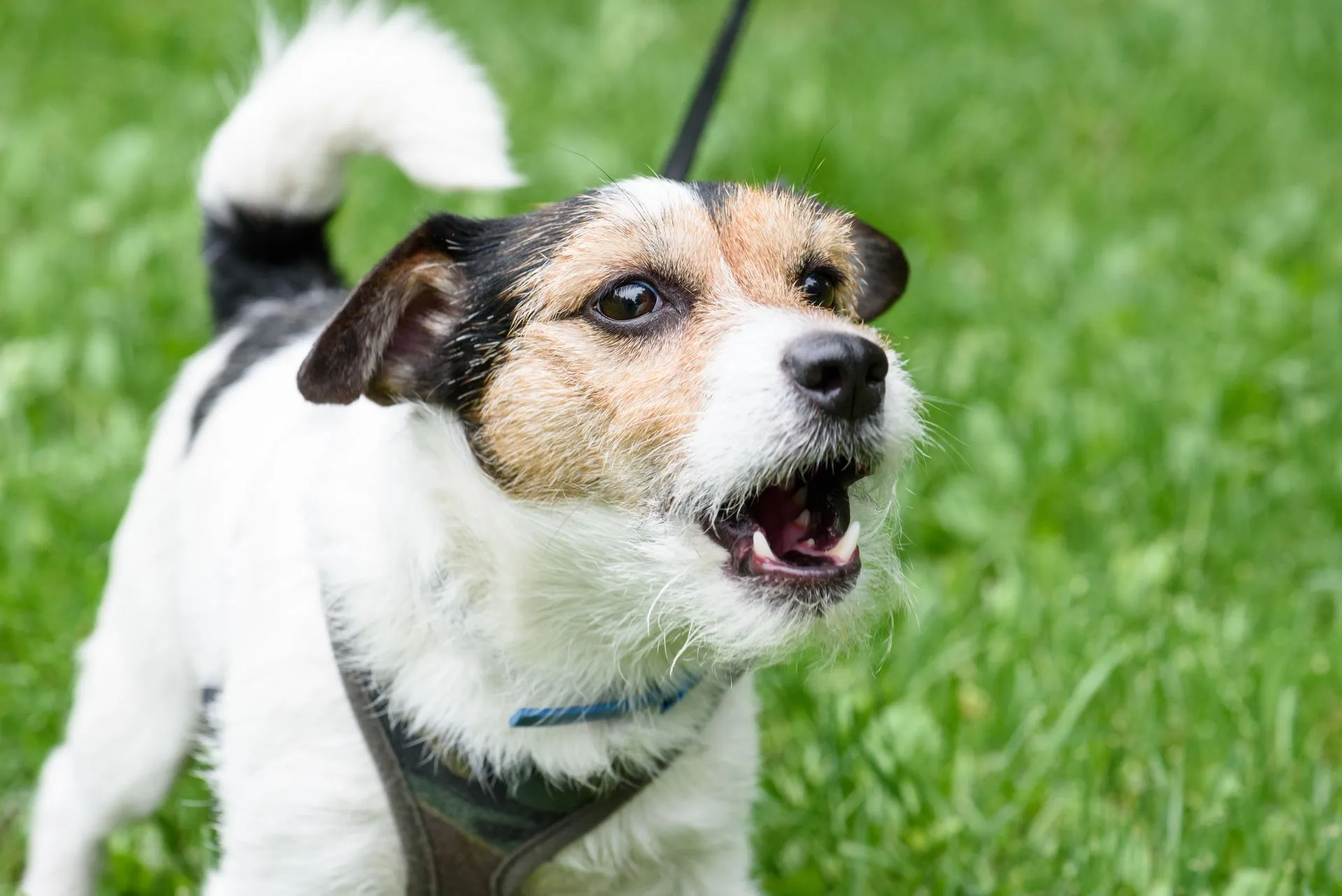Picture this common scenario: your beloved canine companion is enjoying a peaceful moment in your front yard or inside the house. Suddenly, a visitor approaches the gate, a delivery person walks up to the door, or a passer-by strolls down the street. What happens next often turns into a chaotic symphony of barks, growls, and frantic jumping. This can be incredibly distressing for both you and your guests, and it’s a behavior many dog owners struggle to manage. If you’ve been searching for effective ways on How To Stop Dog Barking When Someone Comes In, you’ve come to the right place.
Many dogs instinctively feel the need to “defend the property” when they perceive an approaching stranger. Their thought process might go something like this: “Someone’s coming! Oh no, I must scare them off! Bark! Panic! Growl! You’re not coming in!” This can escalate into aggressive displays, with dogs jumping up on gates or lunging towards visitors, creating a potentially serious problem. Not only is it upsetting for visitors, but an unchecked dog can even bite, leading to severe consequences for everyone involved. dog dominance behavior with other dogs can sometimes be a factor in these territorial displays.
Understanding Why Your Dog Barks at Visitors
The primary cause of excessive barking at visitors is often anxiety, coupled with a strong territorial instinct. Your dog might feel that the front garden or driveway is an area they are supposed to dominate and protect. Any person entering this perceived territory is seen as an intruder. This is a natural instinct, but it’s crucial to differentiate it from the controlled behavior desired in a well-adjusted family pet. While a guard dog might be trained for such reactions, it’s typically not the behavior you want from your companion animal. Training focuses on shifting this mindset from “defend and protect” to “someone’s coming, I’ll go to my safe place.”
Territorial barking can be a complex issue, sometimes stemming from underlying insecurities or a lack of proper socialization. Dogs that aren’t confident in their environment or in their owner’s ability to handle perceived threats may take on the role of “protector” themselves. It’s essential to address this root cause rather than just suppressing the barking, as true behavioral change comes from altering the dog’s emotional response to visitors. Recognizing these triggers is the first step in learning how to stop dog barking when someone comes in effectively and humanely.
 A dog stands alert at a gate, looking towards a person approaching in the distance.
A dog stands alert at a gate, looking towards a person approaching in the distance.
Six Steps to Train Your Dog to Stop Barking at the Door
By following these structured, reward-based training methods, you can teach your dog a new, calmer response to visitors. The goal is for your dog to learn that a visitor’s arrival signals a time to retreat to their designated safe spot, anticipating a reward for their calm behavior.
1. Simulate the Scenario Repeatedly
Effective training requires repetition. Since visitors may not arrive consistently throughout the day, you’ll need to create controlled scenarios. Enlist the help of friends, family, or neighbors to act as visitors, delivery people, or passers-by. Ask them to text you when they are about to approach, allowing you to be prepared for the training session. This consistent practice is crucial, just as you wouldn’t expect a dog to learn to sit by practicing only once a day. This repetitive exposure helps your dog generalize the desired behavior across different “strangers” and situations.
2. Start with a Leash and Your Presence
Knowing when a “visitor” is coming allows you to be ready to intervene. As your friend approaches your house or gate and your dog starts to react by barking or jumping, immediately use the ‘leave’ command. Simultaneously, point towards the house or their bed and say “in.” Gently guide your dog on the lead back into the house, walking them calmly to heel. The key here is to interrupt the unwanted behavior before it escalates, showing your dog that you are in control of the situation. This initial structure provides the guidance they need.
3. Use the ‘Leave’ Command with a Reward (Delayed)
Once your dog is inside and in their designated bed, place a high-value treat on the floor next to them. Crucially, use the ‘leave’ command again, instructing them not to eat it yet. This teaches impulse control. You then go and attend to your “visitor” while your dog remains calmly in their bed. After the “visit” is complete, return to your dog, allow them to have the treat, and offer plenty of verbal praise for their calm behavior. This delayed gratification reinforces the idea that quiet, calm behavior during a visit leads to a reward.
 A dog lies calmly in its bed, looking out a window, demonstrating a relaxed demeanor.
A dog lies calmly in its bed, looking out a window, demonstrating a relaxed demeanor.
4. Progress to Off-Leash Training
As your dog begins to understand and perform steps two and three consistently while on the leash and with your direct guidance, you can gradually transition to off-leash training. The commands ‘leave’ and ‘in’ remain central. Continue to rinse and repeat the scenario. If your dog starts to react as a visitor approaches, use ‘leave’ to interrupt, then direct them indoors with ‘in.’ Follow them inside, remaining calm, and prepare to reward them once they are settled in their bed. This phase builds independence and confidence in their new behavior. Ensuring your dog understands how do you train a dog to walk off leash is also helpful for overall obedience.
5. Bring Visitors Inside to Meet Your Dog
While some visitors may simply be making deliveries, for those who stay longer, it’s beneficial for your dog to see them enter the house. This reinforces the message that there was nothing to worry about. Once your dog is reliably running inside and settling in their bed for a reward, bring the visitors into the house with you. Walk past your dog, initially ignoring them. Then, either you or one of the visitors can reward the dog for their calm behavior. Allow some interaction, showing your dog that people coming into the house is a positive experience. This helps to complete the cycle, transforming their anxious reaction into a positive association with guests.
 A dog lies calmly in its bed with a treat placed nearby, demonstrating successful 'leave' command training.
A dog lies calmly in its bed with a treat placed nearby, demonstrating successful 'leave' command training.
6. Age is Just a Number: Any Dog Can Learn
It’s a common misconception that older dogs cannot learn new tricks or behaviors. Just like humans, dogs are capable of learning throughout their lives. There’s no reason why a dog of any age – seven, eight, or even older – cannot learn to stop barking excessively at visitors. While older dogs might take a little longer to adjust, and sometimes require an initial “kickstart” with a surprise tactic to break old habits, persistence and consistency will yield results. Your canine companion will learn that there is nothing to fear from people passing by or entering your home, strengthening the beautiful bond of trust and love you share. It’s about reassuring them that you are calm and in control, and they can implicitly trust you to handle the situation. For some dogs, you might also want to practice how to get your dog to bark naturally in appropriate contexts, but that’s a different kind of training.
 A dog barks vigorously at an unseen stimulus, emphasizing the behavior we are trying to mitigate.
A dog barks vigorously at an unseen stimulus, emphasizing the behavior we are trying to mitigate.
Conclusion
Training your dog to stop barking when someone comes in is a rewarding process that builds trust, reduces stress for both you and your dog, and makes your home a more welcoming place. By understanding the underlying causes of their barking – often anxiety and territorial instincts – and consistently applying these reward-based methods, you can help your dog develop a calm and confident response to visitors. Remember to be patient, consistent, and always reinforce positive behavior. With dedication, your dog will learn that the arrival of guests means peace and a treat, rather than a perceived threat. Embrace this journey of training, and you’ll foster a stronger, more harmonious relationship with your beloved pet.
For more detailed advice on positive, reward-based training methods, or to explore one-to-one training sessions and residential training, consider seeking guidance from professional dog trainers.
